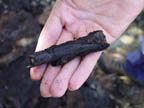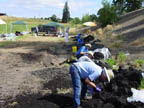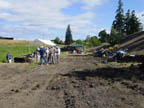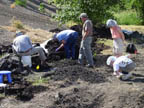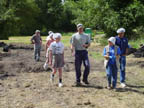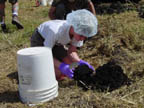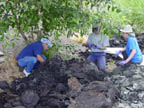Search and Rescue Report |
7/8/2006 - 7/15/2006 |
| Pleistocene Fossil Deposits in Woodburn, Oregon Notes from a Lecture and Field Trip hosted by Allison Stenger, Director of Research Institute of Archeological Studies, June 1 and July 15, 2006 About 10 to 12 thousand years ago, the Willamette Valley looked a little different than it does now; but not so different that we wouldn't recognize it. Certainly the development of technology and artificial habitat for humans wouldn't occur until around hundred and fifty years ago, but the natural environment started looking more like what we see today. The repeated deluge of flood waters from Lake Missoula had ceased and the ice age was drawing to a close. The Willamette River settled into its new path, leaving bogs and backwater swamps where it once flowed. One major part of the ecosystem was a lot different, however. The animals that roamed the land were quite unlike what we might see today. Large bison, mammoths, mastodons, camels, ground sloths, dire wolves, and large raptor birds the size of cars were regular visitors to these swamps. Fortunately for paleontologists today, the remains of these extinct animals are being discovered preserved right where they lived... and died. Professional, meticulous excavations are now yielding an amazing record of these creatures, leading to detailed illustrations of what life was like here in the valley before modern tribes of humans arrived. Allison Stenger, Director of Research at the Institute of Archeological Studies is currently leading an excavation in Woodburn at a location known for it's concentration of preserved bones. The specimens, mostly disarticulated, were trapped in an anoxic layer of silt and peat, and covered by a deposit of thick, sticky, wet clay. With a regular crew of volunteer paleontologists, along with occasional guests, tons of material is carefully being sifted through in hopes of finding specimens of not only mammals, but possibly early humans. The research team has had much success. Reports from the past ten years of excavations are suggesting the animals were typically browsers and grazers. Unlike the La Brea Tar Pits in Los Angeles where the predator to prey ratio is 80% to 20%, the Woodburn bogs are more representative of a typical ecosystem with 80% prey and 20% predators. With supporting evidence, such as the horizontal stratification of wind-blown silt covering the specimens, it is believed that the animals died, not by drowning or other catastrophic events, but by natural causes. In addition to animals, the evidence has been discovered to confirm the presence of humans. Charcoaled buffalo bones were found, suggesting "buffalo wings" might have been on the prehistoric menu. More exciting than that however, is the discovery of human hair that is not related to any current Native American tribes. The theory is that the population from that time is gone. Based on all the evidence, that particular DNA line ended around 11,500 years ago. The traditional "Native American Tribes" we know today didn't arrive in the valley until around 8,000 years ago. Stenger's theory for the extinction of the Woodburn ice age mammals was caused by: stress to the animal populations due to climate changes; hunting by early humans; and most importantly, disease. Herd populations had to join together to share habitat. Decreased food supplies resulted in unhealthy populations and a decrease in immunity to disease. Immunity to disease is a critical component to any healthy population. Otherwise, eventually all animals and people are erased from the universe's database. On a warm July Saturday, members of NARG (Andrew Bland, Steven Bland, Andy Burcholz, Bill Sullivan, Aaron Currier, Tami and MacKenzie Smith) visited the Woodburn dig site to get a first-hand glimpse of the excavation process. Andy, Aaron and MacKenzie even volunteered for a few hours to assist the research crew. Although mostly seeds and beetles were found by NARG members, others in the team did unearth a few bird bones and a single large mammal bone that afternoon. |
| ©2004 NARG - North America Research Group |







